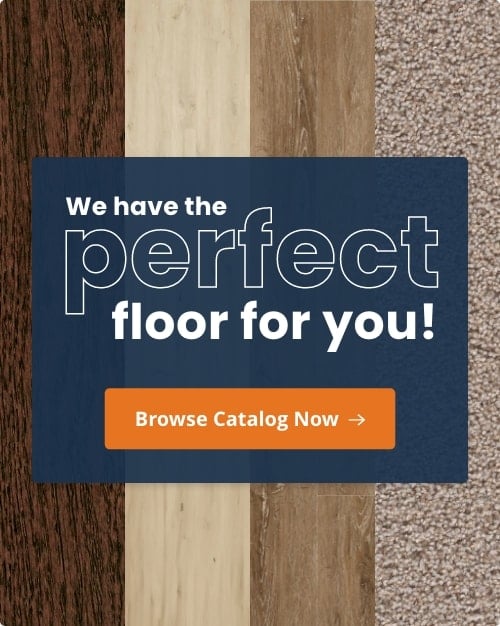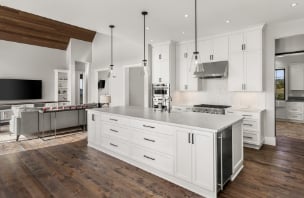You might not think much about the temperature and humidity in your home. After all, all you have to do is adjust the thermostat when it gets too hot or cold to live in your home comfortably. But your environment affects more than just the people in your household — it can also directly impact your hardwood or laminate flooring.
You probably start to notice significant changes in humidity when the seasons change — and so do your floors. Here are some tips to keep them from expanding or contracting over exceptionally high- or low-humidity months.
The ideal house humidity level for hardwood floors is 30-50%, according to the National Wood Floor Association (NWFA). If your home is above this ideal humidity range, condensation and humidity can harm your hardwood flooring. High humidity can also negatively impact you, allowing mold, viruses, dust mites and bacteria to thrive. Dryer air, on the other hand, can harm your flooring, too.
How Does Humidity Affect Flooring?
Laminate and hardwood floors are a beautiful and affordable flooring option, but they are also susceptible to expand, contract, buckle, crown and crack due to seasonal humidity changes. Both winter and summer often negatively affect the durability of your floors. Here’s how:
- Winter: Over the winter, you might heat your home with a fireplace or wood stove. When you introduce this heat into your home, your laminate or hardwood floors can give up their moisture and shrink, causing cracks to appear between planks. However, unless significant damage has occurred, most gaps will close on their own once the humidity levels rise in the spring.
- Summer: In the summer, your indoor humidity can increase to as much as 90 percent, causing your hardwood or laminate floors to expand and swell. Too much swelling causes them to have a crowned or cupped look.
What Can Humidity Do to Your Floors?
Humidity levels that are too high or low can cause:
- Gapping. Lower humidity levels can decrease the moisture in your wood floors, causing wood planks to shrink. This can then create gaps between the planks. In most cases, these gaps will close once normal humidity levels return.
- Cupping. When there is a moisture problem in your home, wood floor planks will sometimes look concave, with the middle of the planks appearing lower than the edges. This can happen when humidity enters the home from below the floor or humidity levels overall are too high, leading to differing levels in the plank. It’s important to find the cause of the cupping and use a dehumidifier or other means to restore balance.
- Crowning. When a floorboard’s surface is covered in moisture, the board can sometimes curve, so the edges are lower than the center. This can also happen if a floor cups and you sand the flooring’s surface before restoring normal moisture.
- Splits. When your home is very dry or humid, a wood floor can weaken to the point where it splits or splinters along the grain. This is permanent damage because it compromises the finish. This problem also worsens with time — since the finish no longer protects the wood floor, moisture and debris can get inside the wood and cause more damage.
- Buckling. The biggest danger of humidity and wood floors is buckling. This happens when moisture causes the wood floor to expand until it moves away from the subfloor. Even when humidity levels drop, there may be gaps between the floorboards.
- Cracking. With high humidity, wood floorboards can expand until they push up against nearby boards. In some cases, these boards can become damaged or cracked.
You can reduce the risks to your floor and health by maintaining a healthy humidity level in your home. Use humidifiers and dehumidifiers as needed and ensure proper ventilation in your home.
Keep in mind there is some variation in humidity during the year. Humidity levels can increase in the summer months, especially during storms. Air can also dry out in the winter months, especially as you use heat. Incorrect ventilation can also cause condensation, potentially leading to water damage on your floors.
Where you live will determine the average humidity levels in your home. For example, if you live in a more humid, tropical climate, you may want to take water risk into account. The best wood flooring for a humid climate may be engineered wood, which can take more moisture or dryness in the air.
How Can You Protect Your Floors?
With the proper care, you can protect your laminate or hardwood flooring from buckling, cracking and otherwise reacting to moisture and seasonal humidity. Try to follow these guidelines to prevent moisture problems in your floors:
- Keep your home’s indoor humidity levels between 40 and 60 percent throughout the year. You can do this by using a humidifier over the winter and a dehumidifier or air conditioner over the summer.
- Avoid using water-based cleaning products on your floor on a regular basis. Instead, only clean using them when needed — and only on dirty areas.
- Never mop on a wood floor, and never let water spills dry on them. This can cause lasting damage to the boards.
- Instead of mopping, clean your floors with a cloth lightly dampened with a cleaning product specifically recommended for wood or laminate.
Contact 50Floor for All Your Flooring Needs
Whether you need more information on protecting your floors from humidity or want to install a new floor after moisture has already affected your home, 50Floor is here to help.
At 50Floor, we do more than just sell you a durable, high-quality floor that matches your needs and budget. We’re also your trusted industry experts for any questions you might have and will walk you through every step of the buying and installation process. Our team will provide the best customer experience available to ensure your peace of mind every step of the way.
Contact us today to learn more about our flooring solutions or to schedule a no-cost consultation.



